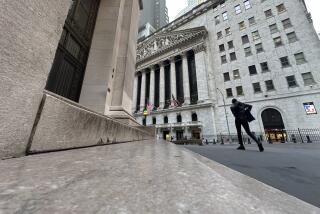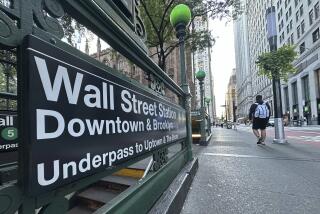Stocks plunge in early trading
- Share via
NEW YORK AND LOS ANGELES — After the stock market tumbled Tuesday, some investors braced for more pain while others breathed a sigh of relief.
The Dow Jones industrials sank 297.81 points, or 3.8%, to 7,552.60 as share prices around the world sank on renewed worries about the health of the banking industry and doubts that governments can patch together a quick economic recovery.
“I have never seen investor confidence lower than it is today,” said Al Goldman, chief market strategist at Wachovia Securities. “The market is saying it’s very unclear how we’re going to solve the toxic-asset problem in banks, and it’s casting a vote that it’s very uncomfortable with the stimulus program.”
A number of market watchers, however, were encouraged that the blue-chip gauge closed above -- if just barely -- its five-year low of 7,552.29 set Nov. 20, suggesting that level might well remain as the nadir of the bear market that began in October 2007.
Although the broader Standard & Poor’s 500 index and Nasdaq composite index fell more sharply than the Dow on Tuesday -- 4.6% and 4.2%, respectively -- the S&P; 500 stayed 4.9% above its November trough and the Nasdaq finished 12% from its low.
Nonetheless, bearish analysts fear that Tuesday’s decline indicates the S&P; 500 and the Dow are poised to fall well into newly negative territory.
“It seems to us as if this market has every intent of retesting [its] low,” said Keith Wirtz, chief investment officer at Fifth Third Asset Management in Cincinnati. “There’s just too much bad news, both now and ahead of us.”
If that happens, some worry, the decline could be painful.
“If we do reach the lows from November, the market could go down 5% or 10%,” said Douglas Peta, an independent market strategist. “I don’t think it’ll just be setting a new low by one or two points and then bouncing back up.”
The short-term economic outlook, Peta argues, has worsened since November. For example, job losses have surged to more than 500,000 a month.
“The stock market is beginning to fear the economy isn’t going to bottom in the next six months and may not bottom in all of 2009,” he said. “We’ve gotten a continuing drumbeat of worsening economic data.”
For much of Tuesday’s session, the Dow seemed to dance just above the 7,552.29 level, bouncing up whenever the index got within range of that number. The Dow then sank to 7,551.33 in the last two minutes before a few final trades managed to push it back up, preventing it from establishing a new closing low.
Some followers of stock charts saw reason to be a bit suspicious of the Dow’s behavior, especially on a day that President Obama signed the $787-billion stimulus bill.
“It’s kind of fishy,” said Ryan Detrick, a market technician at Schaeffer’s Investment Research in Cincinnati.
There was no single trigger behind Tuesday’s sell-off. It stemmed from a persistent stream of concerns, including worries that General Motors could be forced into bankruptcy and mounting anxiety about European banks. GM shares cratered 13%.
The financial sector was the worst-performing of the S&P;’s 10 major industry groups, diving 9.8% as all of the index’s 81 financial stocks skidded. Shares of Wells Fargo, Bank of America and Citigroup plummeted 12% or more.
In Europe, after falling Monday while Wall Street was closed for a long weekend, key stock indexes slumped 2.4% in Britain, 3.4% in Germany and 2.9% in France.
While investors wait to see whether the battered stock market can hold above last year’s lows, the commodity market already has plunged into new bear territory.
The Reuters/Jefferies CRB index of 19 major commodities dropped 4.6% on Tuesday to its lowest level since 2002 as oil, copper, soybeans and most other commodities lost ground on expectations that the global recession would mean declining demand for raw materials in general this year.
“Fear of across-the-board demand destruction is keeping these markets under pressure,” said William O’Neill, a veteran commodities analyst at Logic Advisors in Upper Saddle River, N.J.
Oil futures dropped $2.58 to $34.93 a barrel, but held above last week’s low of $33.98.
Copper, which had rallied modestly in January, dived 7.5% for the day after losing 4.5% last week. Wheat, aluminum, heating oil, coffee and sugar also got hammered.
But what’s bad for most commodities is a boon for precious metals: Gold, silver and platinum have surged, adding to their gains of recent weeks, as some investors have turned to those classic havens from global financial and economic upheaval.
Gold futures jumped $25.50, or 2.7%, to $967 an ounce, the highest since the metal reached $978 in mid-July, and knocking on the door of the $1,000 mark, which gold briefly traded above last March.
The yield on the 10-year Treasury note fell to 2.66% from 2.88% on Friday.
--
More to Read
Inside the business of entertainment
The Wide Shot brings you news, analysis and insights on everything from streaming wars to production — and what it all means for the future.
You may occasionally receive promotional content from the Los Angeles Times.










